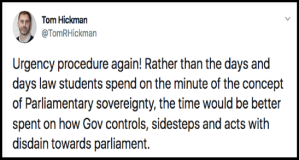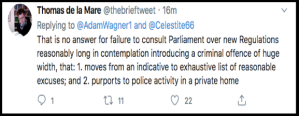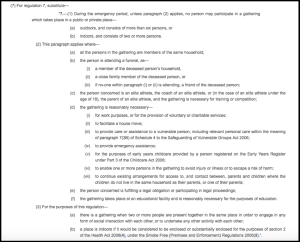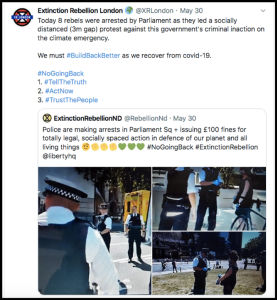In late July, the Supreme Court heard two days’ argument on one of the liveliest, and contentious, issues in protest law: how far should domestic law tolerate disruptive or obstructive protesters being able to say they had a “lawful” or “reasonable” excuse for their actions, specifically they were ‘simply’ exercising their right to protest peacefully? The case – Reference by the Attorney General for Northern Ireland – Abortion Services (Safe Access Zones) (Northern Ireland) Bill – is a little more complicated in that the issue was how far should a court “read in” such a defence where the Act, the statute was silent i.e. where there was no defence? Reading in is a Human Rights Act tool, or notion, done to render compatibility between domestic law and the ECHR. To that extent, when it is decided, it will operate in tandem with another important Supreme Court decision in June 2021: Ziegler. This settled the easier issue – legally speaking anyway: where a statute creating a criminal offence included a reasonable/lawful excuse defence, a disruptive or obstructive protester could avail themselves of that by demonstrating that ‘all’ they were doing was protesting non-violently. It would be for the State, for the CPS, to show that it would nonetheless not be a disproportionate interference with the exercise of that right to convict. Lord Hamblen in that case (at para [71] onwards) indicated some of the factors that should be taken into account in making that assessment.
There is still some dispute about whether or not Ziegler is limited to allowing disruptive/obstructive protesters to lay claim to that defence only if charged with obstruction of the highway (as they were in that case) contrary to s.137 Highways Act 1980 or is it of more general application to all crimes with reasonable/lawful excuse defences written in? That may well be decided by another protest case working its way through the courts, the Attorney General’s referral to the Court of Appeal in the Colston Four case. This was argued in late June, and judgment is awaited.
To a considerable degree, the legal issues in the current NI Supreme Court challenge reflects a High Court decision earlier this year, Cuciurean (an appeal by way of case stated) – where the defendant lost (and on which see this blog of mine), that is he was unsuccessful in persuading the Court that where an Act creates an offence but is silent about defences then a Court would not read one in. The crime there was aggravated trespass, under s.68 of the Criminal Justice and Public Order Act (CJPOA) 1994. Although leave to appeal to the Supreme Court was given in Cuciurean, the case will not proceed there as it has been dropped by the defendant. That seems a shame to me as clarity in the law from the highest court would have been welcome, more so as the Supreme Court might well take the opportunity in the AG NI Reference to offer views on the position, but without having heard full argument and indeed where the issues do not fully overlap. That might be problematic to put it mildly.
This blog provides a critique of the short critique of the case law in the area, or some of it anyway. It does not seek to answer the normative “ought” question of whether and how far society – and within that, our legal system – should tolerate such forms of civil disobedience and direct action as constituting legitimate political activity. We might think here of the local action in Peckham in June to obstruct a Home Office deportation and in July, Just Stop Oil activists gluing themselves to artworks and a vegan activist group who poured milk over the floor of Harrods. In other words, it will not solve the question of whether or not taking direct action is, could be or should never be a proportionate political response to a perceived socio-economic or other problem. Its focus is simply doctrinal and to a lesser degree socio-legal: what does and what might case law tell us, and how the law might play out?
The facts of the AG NI reference are straightforward enough to provide context for the challenge and discussion. The Abortion Services (Safe Access Zones) Bill, a proposed Northern Irish law, put before the Assembly by a backbench member, allows for the automatic creation of 100m “safe access zones” outside any abortion clinic. This is enforced by means of criminal offences such as (cl. 5(2)(a), the subject of the present challenge: doing an act “in a safe access zone with the intent of, or reckless as to whether it has the effect of influencing a protected person, whether directly or indirectly.” The Bill contains no express or patent “reasonable excuse” or similar defences. It is unlawful, as a matter of the devolved framework for Northern Ireland, to pass laws that are not compatible with the ECHR. Thus, the question for the Supreme Court was whether that provision disproportionately interfered with the rights of persons who wish to express their opposition to the provision of abortion treatment services in Northern Ireland, that is constituted a disproportionate restriction on the exercise of the Article 10/11 rights of Northern Irish citizens to protest. If it did, it would be beyond the competence of the Assembly to pass it. The case then turned on whether such protections for free speech should, could or even must be read into that void. If they could etc, the Bill would be lawful in devolved terms.
In effect then, the appeal turns on whether the High Court was right to hold in Cuciurean that an Act is a self-contained system, one which does not need a defence to be read in – had Parliament wished to confer one, it would have done – and the Human Rights Act (HRA) adds nothing to that. In doing so, it preferred one line of case law over another, and we might reasonably assume, the Supreme Court in the instant AG NI Reference, will have that choice before it too. My argument is that the High Court in Cuciurean was wrong to favour that line of case law – Bauer and James – over Connolly, Dehal, Scottow (in 2020) and Lee Brown (in the Northern Ireland Court of Appeal in 2021) and so there is no reason for the Supreme Court in the instant Reference to follow suit. Indeed, there are good reasons to prefer the Connolly line. The arguments are:-
- There was a series of judicial missteps in that former line of case law culminating in quite an erratic path being sown
- Relatedly, the role played by proportionality in such criminal prosecutions has been misunderstood and/or confused.
- The express holding in Cuciurean that Parliament has already struck the Convention balance in framing the section does not stand up to scrutiny
- There is equally a line of Strasbourg case law that supports the contention that “reasonable excuse” can come into play despite there being no express warrant on the face of domestic legislation.
First, there is good, existing High Court authority that holds that a court may, indeed perhaps should, read words in to create a defence where there was none. That case is Connolly from 2007. A devout Catholic was charged under s.1 of the Malicious Communications Act 1988 with sending grossly offensive or indecent communications, viz. photos of aborted foetuses to local pharmacists, as part of her campaign against abortion. There are no defences in the 1988; it is made out provided the Crown proves the sender’s purpose is to cause distress or anxiety to the recipient. Dyson LJ was prepared to take one of two routes to interpreting the statute in line with the ECHR. First, to give a heightened, more Convention-compatible reading to the words “grossly offensive” or “indecent” and secondly (at [18]) to “read into section 1 a provision to the effect that the section will not apply where to create an offence would be a breach of a person’s Convention rights, ie a breach of article 10(1), not justified under article 10(2)….[which is] the inevitable consequence of section 3 of the HRA.” Connolly was binding on the High Court in Cuciurean yet it is not cited despite being referred to in argument by his counsel.
There are similarly supportive cases such as Scottow in 2020 (similarly a prosecution for malicious communications on Twitter under s.127 Communications Act 2003) and Lee Brown in 2021 (hate speech under the Northern Irish equivalent of s.19 POA 1986) but these might better be seen as cases in which either the decision to prosecute or the conviction were assessed for proportionality, which is not quite the same thing. Here, it is probably true that those two cases conflict with what was said and decided in both Bauer and in James – but even if that is right, it still leaves open as good, clear authority for the proposition that it is open to a court to read a statute that creates an offence as subject to implied limitations, in effect creating a form of Convention-based defence even if there is no express “reasonable excuse” to hang it upon. It would of course be open to the Supreme Court as the higher court to overrule it, but that needs to be done clearly and deliberately and in a reasoned fashion
I am not entirely convinced in any event that Bauer and James stand up as well as the Court in Cuciurean thought they did. Bauer in part depends on the rejection by the same judge – Moses LJ – of a decision he reached a few years earlier in Dehal. With all respect, this is not convincingly done and there is confusion about what that earlier case decided and how it was reasoned. James too is open to question. Again, the Court misconceptualises Dehal, on the question of proportionality. More critically, the case is about the prosecution for failing to obey a police direction at a protest. It is here, the giving of a direction, the Court says is where questions of proportionality can be decided. It is in short, easier to support and to fathom a decision holding there should be no proportionality defence read in, in cases where a protester is not totally debarred from doing so.
Another important factor in the High Court decision in Cuciurean, and critical to its reasoning is its holding that in all cases where Parliament has established a framework for the creation of an offence, that framework is self-contained. Not only does no defence need to be read in if there is not one, but the Court must assume that Parliament has already conducted a proportionality exercise and decided where the appropriate balance between rights and social order should be struck. This is not a sustainable position and flies in the face of principle and case law. It is unprincipled since the whole scheme of the HRA, and s.6 in particular which imposes duties of Convention-compliance on public authorities, including courts, is one where decisions by other state agents e.g. the police, are subject to review on grounds of proportionality. It is not and never has been an answer to the exercise of discretionary power – such as would occur with arrests of protesters for crimes – to say: “Parliament has struck the balance. There is no role for you, the judge to play. My decisions are not amenable to challenge on human rights grounds of proportionality.” If such were the case, not only would be it be unprincipled and lacking in normative appropriateness, it goes against the grain of countless cases, both policing/protest and more widely. Brehony is a protest case on point, the challenge to the imposition of s14 conditions on an assembly outside Marks and Spencer in Manchester. Bean J ([23]) was “content to assume that the Chief Constable’s decision in this case is reviewable on proportionality grounds.” Percy – an appeal against conviction under s.5 POA 1986 for a peace campaigner who daubed “No To Star Wars” on the US flag outside a USAF airbase in Suffolk – and a little further back, Singh – a dispersal order case that reached the Court of Appeal under the old s.30 Anti-social Behaviour Act 2003 – would be others.
What I think the Court has done in Cuciurean is confuse and conflate two different forms of proportionality; the discretionary legislative scheme in the abstract and the specific operation of the discretion on the ground in any instant situation. It is, or might be, perfectly fine to eschew judicial control of the former, but not or never of the latter. Overd and Others v CC Avon and Somerset is a recent example of that latter where (at paras [83]-[84]) the Court assessed, in Article 9/10 terms, the proportionality of the arrest of a group of four Christian preachers for racially aggravated s.5 offence and s.50 Police Reform etc Act 2002. Other cases support that, and to the extent that Saini J in the recent Divisional Court decision in Bennett is saying different, again with respect I think His Lordship may have elided two different things.
There is another reason to treat Cuciurean with caution on the proportionality point, that Parliament has already, and conclusively, struck the Convention balance when it framed the section. It is this. An arbitrary division arises, between those offences which have an inbuilt defence and those which do not. Of course, there is the retort that this is deliberately of Parliament’s making, of its own volition. That might be true but my own research into the passing of the CJPOA and s.68 specifically shows that the question of whether or not to include a defence might well not be one that is put before Parliament at all. Are we right and sensible to conclude this is still a positive choice by parliamentarians? I am doubtful that we should, and certainly if its end-point is the removal courts and judges from the equation as possible defenders of rights (one effective reading of s.6) and consequent shifting of all the power onto the police. They alone have the power to decide which of various offences to charge a disruptive protester with – and putting it as neutrally as possible, why would an officer arrest someone for intentional nuisance (now in statutory form, in s.78 Police Crime etc Act 2022) which has a “reasonable excuse” defence written in, in s.78(3) rather than aggravated trespass which does not?
The last point to make is that at Strasbourg level (i.e. at the European Court of Human Rights) there is no indication in the case law that a pivotal factor is the absence or presence of something akin to a “reasonable excuse” defence. There are several cases where the Court has considered the proportionality of any charge/arrest/conviction even if it has not then gone on to determine that there was no violation because the state’s response was disproportionate. Cuciurean precludes a court from even that first investigation, let alone the conclusion. My own research has produced the following three:
- Barraco v France: a road obstruction case, from 2009 in which protesters were charged under L412-1 of the Code de la Route (judgment only in French)
- Kudrevicius v Lithuania: similarly a road block protest, decided by the Court in 2015, in which the farmers were charged under Article 1241 of the Code of Administrative Law Offences.
- Drieman v Norway: this was a Greenpeace protest trying to disrupt whale fishing off the Norwegian coast, and the group was charged under s. 14 and 53 of the Sea Waters Fisheries Act
What we will soon know is whether the AG Northern Ireland’s Reference might mark a turning point – with marginalisation of Ziegler to its very specific facts, and effective approval of the line in the sand marked by Cuciurean – or will it mark a continuation of that route? Of course, and perhaps to conclude here, how far either remain “good law” if and when the planned reforms to the HRA, and especially the watering down of the “so far as possible” test in current s.3, but that remains a protest to come!




